Impacts of Recent Market Volatility On Aqufeeds In Western Europe And Asia
The aquafeed industry is reliant on a basket of common input ingredients such as soybean, corn, fish oil, rice and wheat for which it competes in the marketplace with other animal protein production sectors such as those raising beef, poultry and pork as well as those producing food for direct human consumption.
Many of these key ingredients traditionally used in recipes for commercial and on-farm aquaculture feeds are internationally traded commodities and, therefore, aquafeed production is also subject to any global market shocks and volatility. Since 2005, the basket commodity price index (CPI) rose by about 50 per cent (Figure 9). During the same period, the price of soybean meal, fishmeal, corn and wheat rose by 67, 55, 124 and 130 per cent, respectively (Figure 9a). Similarly, the cost of major oils used in the feed industry increased by up to 250 per cent (Figure 9b).
The price of these ingredients has increased dramatically since the millennium but the rate of price increase has occurred in two phases; a steady gradual increase in prices until around 2004 followed by a dramatic exponential rise and then slight fall in the latter half of 2008 (Figure 9). The major drivers impacting on the prices of ingredients commonly used in aquafeeds are outlined below.
Trends in fuel costs and impacts on aquafeed production and use
The escalation in demand for commodity feed ingredients coincided with the dramatic increase in fuel prices since 2004, peaking at over US$130/barrel in July 2008 (Figure 10). Since 2005, the price index for crude oil soared to 250 per cent but slipped back to around US$ 50/barrel by the end of 2008, before rising again to $70/barrel.

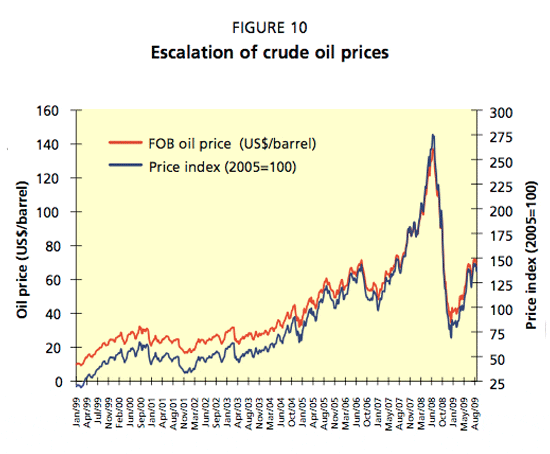
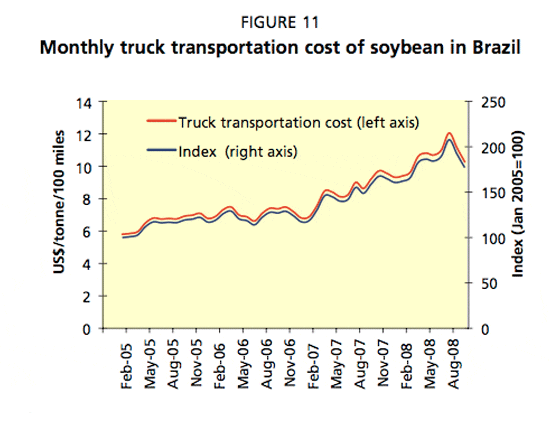
This rise in fuel costs impacted heavily on transportation and production costs of those industries relying on feed ingredients and other commodities, leading to an increase in the landed cost of those ingredients. The key commodities used in aquafeed production are corn, soybean, fishmeal and oil, all of which are largely sourced from the Americas, notably Brazil, the United States of America, Chile and Argentina, and have to be shipped to major markets.
In Brazil, where production areas can be over 1 000 miles from sea ports, trucks are predominantly used to transport soybean. The cost of this transportation, illustrated in Figure 11, has also escalated owing to rising fuel prices. The cost of land transportation has doubled from US$6/100 miles in January 2005 to over US$12/100 miles in July 2008 (Figure 11). Similarly, fuel prices further impacted on the landed costs of feed ingredients due to increased sea freight costs. Thus, total transportation costs increased substantially.
In Brazil, for example, the total cost for transporting 1 tonne of soybean increased by 35 per cent in just two years, from US$127 in 2005 to US$171 in 2007. Rising demand and production costs increased the farm value of soybean by 42 per cent.
Rising oil prices impacted on the costs of fertilizers, equipment and operations. Triple super phosphate and urea prices, for example, rose from US$202 to US$909/tonne and US$223 to US$509/tonne from 2006 to 2008 (July), respectively. Overall, the landed cost of soybean from Brazil increased by 39 per cent in just two years (Table 17).
Trucks are predominantly used to transport soybean in Brazil. The cost of this transportation has escalated owing to rising fuel prices and is illustrated in Figure 11. Since January 2005, the cost of land transport increased by 23 per cent (Figure 11). In addition to fuel hikes, the sharp rise in sea freight was compounded by the concurrent increasing demand mainly by China for dry and container cargo ships for transportation of coal, iron ore and grain.
The Baltic Exchange Dry Index, an internationally recognized measure of sea freight cost, rose from 5 000 in January 2005 to over 11 000 in July 2008.
Diversification of human eating habits and new uses of traditional commodities and the implications for aquafeed
The price shocks were an unusual confluence of several primary and secondary factors, which disrupted the global demand and supply balance of the commodities used for feed ingredients. The impact has been greatest since 2000. Over the last decade, the strong increase in economic growth, especially in developing countries, together with the increase in population size, have raised the demand for food.
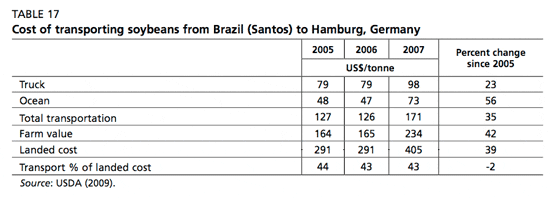
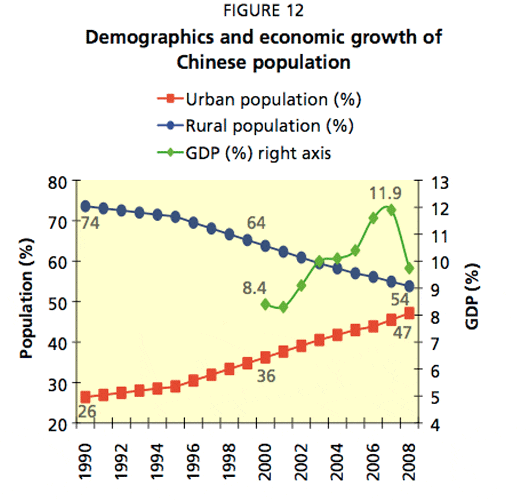
While the economic growth of developed countries declined from 3.6 to 2.2 per cent per year between 2000 and 2007, the economies of developing countries, especially Asian countries, grew at a staggering rate of 7 to 10 per cent per year in the same period (International Monetary Fund, 2009). The increase in disposable income and prosperity was also accompanied by a notable shift in the dietary preferences of consumers in these countries as they diversified their diets to include more meat, fish and milk products, which consequently increased the demand for grains, the principal ingredient used in animal feeds. The poorer conversion ratios of feed to meat of around 2–8:1 compared with that of feed to fish of around 1–2:1 amplified the demand for the common aquafeed ingredients. Moreover, these changes occurred in the most populous countries in the world, notably in China, which had the greatest impact by skewing the global distribution of grain commodities. The impact of China, therefore, is discussed here as a special case.
The demands placed by China on world commodity supplies used in aquafeeds were also fuelled by internal demographic and structural changes (Figure 12). Growth of the urban population averaged 4.3 per cent per year from 1990 to 2006 and was expected to reach 6 per cent per year by 2008. Urban population, which was 36 per cent of total population in 2000, reached 44 per cent in 2006 and 47 per cent in 2008 (Figure 12). There was a concomitant decline in rural population by 20 per cent, from 74 per cent in 1990 to 54 per cent in 2008 (Figure 12). These changes should be seen also in the context of differential per capita income and purchasing patterns between the rural and urban populations.
The per capita income of a person in an urban area is significantly greater than that of a person in a rural area and has risen at a significantly higher rate. Between 2000 and 2006, urban per capita annual income increased by 90 per cent, from RMB6 280 to RMB11 760, compared with an increase of rural per capita annual income of 60 per cent, from RMB2 253 to RMB3 600. Such an increase in affluence facilitated shifts in dietary lifestyle, with huge increases in the consumption of meat and milk products accompanied by a decline in grain consumption (Figure 13). In urban populations, consumption of milk, aquatic products, eggs and meat increased by 296, 68, 44 and 28 per cent, respectively, from 1990 to 2006, while in the same period in rural areas increase of consumption of these same items were 186, 135, 108 and 77 per cent, respectively (Figure 13).
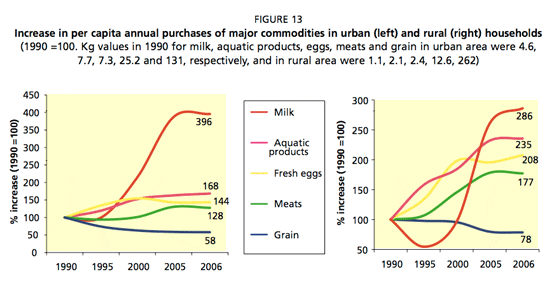
To meet this demand, animal production absorbed a significant tonnage of grains. Furthermore, the demand for oils (soybean, rapeseed and palm oil) also increased dramatically. Against this backdrop of sharply rising demand in China as well as in other populous developing economies such as India, the demand for all ingredients used in aquafeeds exerted significant upward pressure on prices. The rate of supply, however, did not keep pace with demand and key reasons for these are mentioned later.
The impact of climate change on the supply of aquafeed ingredients
Plant ingredients used in aquafeedsThe uncertainly concerning the availability of traditional fishmeal and fish oil and rising prices have required major industrial aquafeed manufactures to identify and evaluate alternate protein and oil sources and considerable progress has been made in recent years on substitution of fish protein and oil with proteins and oils of plant origin. Grain crop yields, as with other arable crops, when negatively affected by variable and adverse weather conditions, increase uncertainty about grain supplies and prices. Therefore, the reliability of grain supplies for aquafeeds in the future will be influenced by short-term weather patterns and long-term predicted global warming directly through its impact on crop yields, crop pests and diseases, and soil fertility and condition. Supply will be also influenced by climate change indirectly through its impacts on economic growth, income distribution and agricultural demand (Schmidhuber and Tubiello, 2007).
During the last few years, unpredictable weather resulted in a critical shortfall of major grain and oilseed ingredients used for on-farm aquafeeds as well as for complete commercial diets. Unfavourable weather reduced crop yield and production in some countries in 2006. The crop yields in the Russian Federation and Ukraine were markedly lower due to drought. Australia encountered two years (2006 and 2007) of severe drought and South Africa also experienced drought. Consequently, the reduced world production and supply of grains and oilseeds contributed to a further decline in the global stock-to-use ratio for aggregate grains and oilseeds, and also to rising prices. In September 2006, maize prices began a significant rise to a new high.
Adverse weather patterns continued into 2007 negatively affecting yields and global grain supplies on most continents and in a great number of key countries supplying global markets with aquafeed ingredients such as rapeseed, soybean and grains. Northern Europe encountered a dry spring and floods during harvesting time, while southeast Europe suffered a drought. The droughts of 2006 in Ukraine and the Russian Federation continued into 2007.
Turkey also experienced drought in 2007, which reduced yields in rain-fed production areas. In the Americas, a late heavy freeze over several consecutive days destroyed large tracts of hard red winter wheat and in the United States of America reduced yields over large areas, while in Canada, a hot and dry summer growing season resulted in lower yields for wheat, barley and rapeseed. In South America, a late freeze followed by a drought in Argentina reduced corn and barley yields (see Box 2).
Droughts in northwest Africa and Australia in 2007 also affected major growing areas. The accumulative result of bad weather in 2007 resulted in the second consecutive drop in global average yields for grains and oilseeds, causing a further decline in the global stocks-to-use ratio and creating uncertainty among importers about the future availability of supplies. This placed an upward pressure on prices of plant proteins and oils used as aquafeed ingredients.
In 2009, a La Niña weather event affected crop production in the Southern Hemisphere, bringing rains to the main arable areas of Australia, serious drought to Argentine wheat production areas, reducing production by 48 per cent, and sufficient rain for cereal crops in South Africa. This weather event, which was characterized by low surface-water temperatures in the Equatorial Pacific, was expected to continue well into March and April 2009.
The predictably of rainfall can also affect supplies of grains. In Australia, in 2009, intermittent rain during the growing season and heavy rains during harvesting time reduced crop yields and available supplies of wheat. It is now widely acknowledged that global weather patterns are unstable and that the frequencies of adverse climatic conditions are likely to increase. Climate change, which is being driven by global warming caused mainly by carbon emissions from industrialized countries, will continue to influence temperature and precipitation patterns around the world. This, in turn, will place severe upward pressure on water supplies in water-stressed regions of the world and may result in shifts in geophysical growing areas for the major protein crops and oil-plant crops yields of which are used in aquafeed production.
The effects of changing weather patterns are complex and several models have been developed to predict the degree of impact of such climate change on agricultural output. All models use varying assumptions (for a comprehensive review see Cline, 2007).
The key assumption is that carbon concentrations in the atmosphere will increase as a result of greenhouse gas emissions from the current (2007) 365 ppm to above a threshold of around 585 ppm, reaching 735 ppm by 2080. This would foster increased production through increased photosynthetic activity, a phenomenon referred to as carbon fertilization, and hence increased yields (Cline, 2007). This positive effect, however, is reduced and reversed when the atmospheric temperature rises above 12–14oC. By combining information on carbon fertilization with information on changes in average annual temperatures and precipitations, Cline (2007) predicted the potential impact of these changes on national agricultural output.
At the regional level, assuming carbon fertilization occurs at the predicted rate, agricultural output in industrialized nations will rise by a predicted 7.7 per cent, whereas that of developing countries will decline by 9 per cent. Similarly, in sub Saharan Africa (SSA), Asia and Latin America, the output is predicted to fall by 17, 7, and 13 per cent, respectively. Thus, SSA and Latin America are the two developing regions most vulnerable to global warming. Countries such as Brazil and Argentina in Latin America, the United States of America and Canada, the Russian Federation, China, India, Malaysia, Indonesia and Australia are major producers and global suppliers of key protein and oils used in aquafeeds.
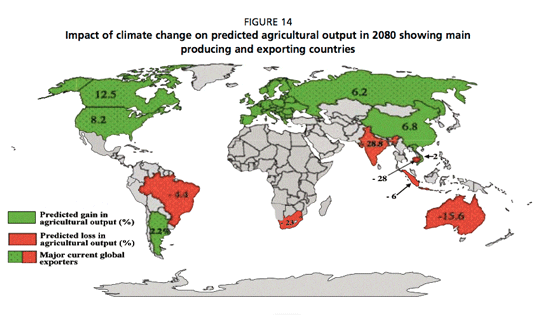
These predicted changes, which show intraregional variation (Figure 14), show production gains for high-latitude countries and production losses for lower-latitude countries, mainly developing nations. To mitigate against such probable losses, countries can limit their losses due to climate change by switching to agricultural imports rather than growing the products imported (Cline, 2007).
Under the present scenario of global warming, the current dependency on imported aquafeed ingredients, such as soybean, maize, rice, wheat, palm oil and rapeseed, is likely to remain and will most likely increase because climate change and pressure on local land resources will reduce the probability of self sufficiency. Moreover, because the main suppliers of soybean, maize and wheat are the United States of America, Brazil and Argentina and the main consumer markets are in Europe and Asia, these supplies will always be vulnerable to price swings due to fuel and transport price volatility and it is highly unlikely that prices of such commodities will reduce to pre-2000 levels for the foreseeable future.
Further Reading
| - | You can view the full report by clicking here. |

